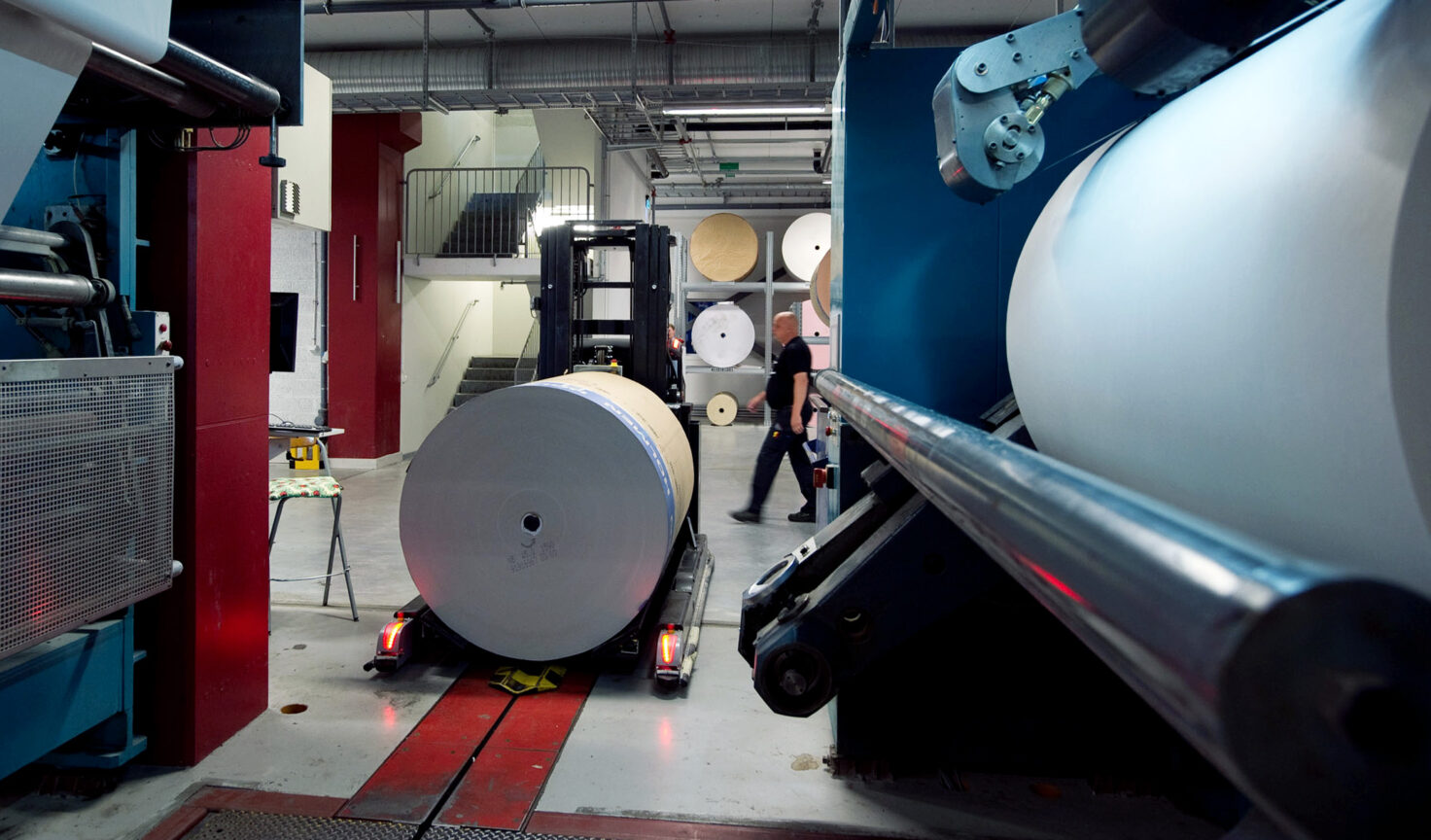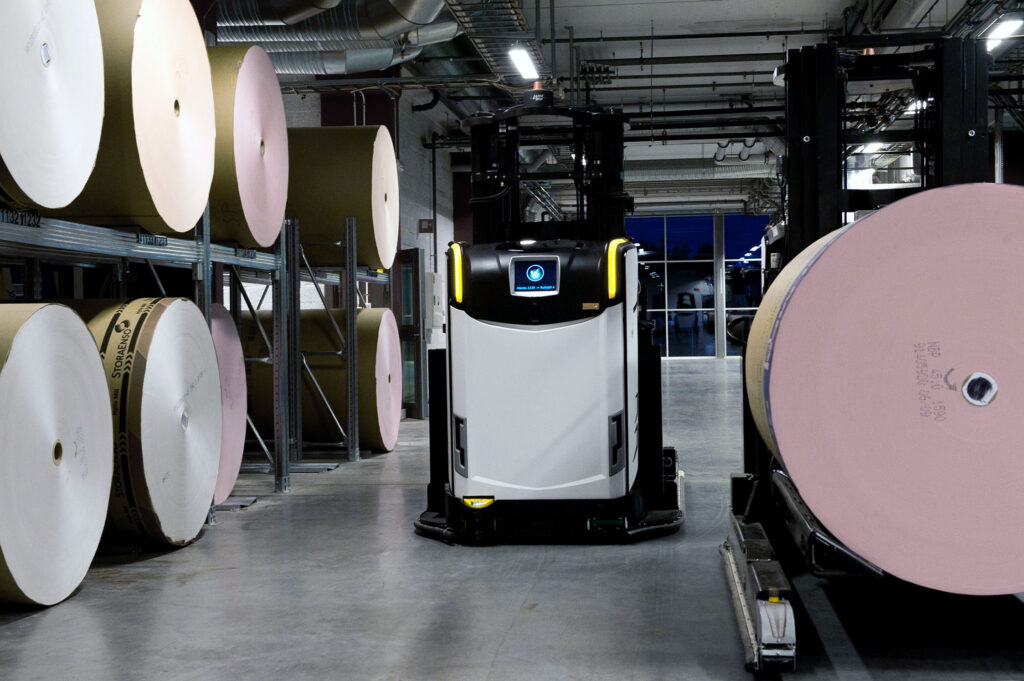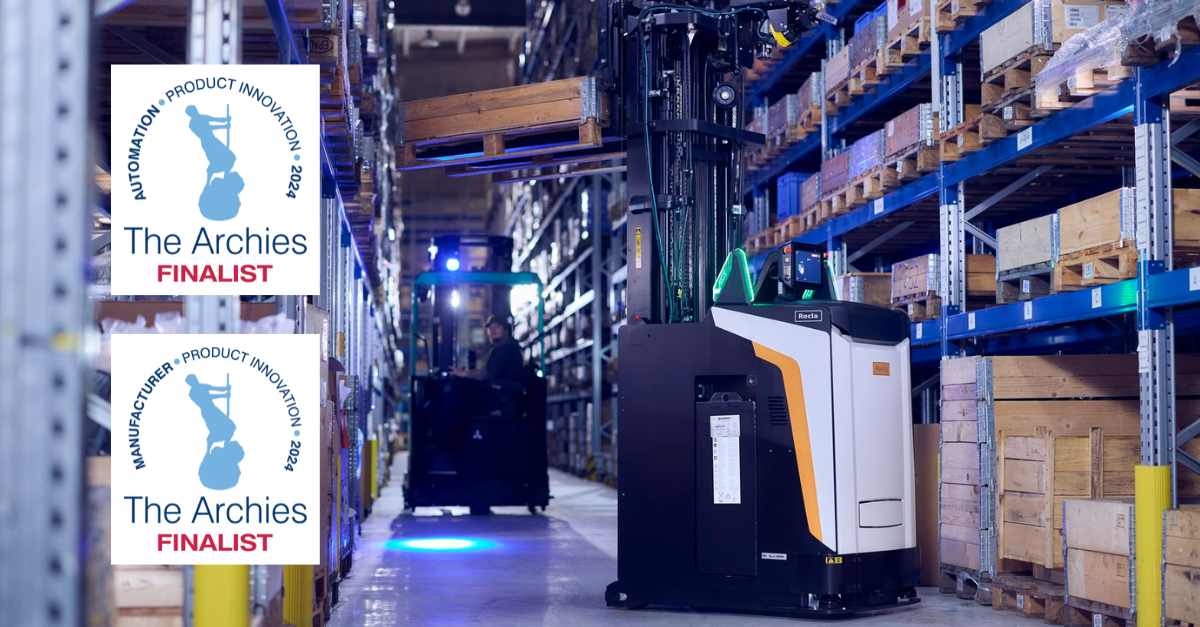AGV systems for horizontal roll transports
Blog post by Antti Aakko
In this blog post, I introduce AGV systems that transport rolls in a horizontal position. As opposed to the vertical position, rolls also need to be handled in the horizontal position, and there are ways to do this with AGVs. Even though I talk about paper rolls, the same techniques can be applied to any product that is in a roll form: paper, different paperboards, films, foils, laminates – you name it.

Paper and paperboard rolls are most often transported and stored in a vertical upright position, but they are usually processed in a horizontal, lying position. This means that rolls need to be handled in a horizontal position for infeed and outfeed (if the product is a roll) of many converting processes. These processes can include, for example, printing, laminating, sheeting, corrugating, coating, and die cutting. Rolls are handled in this orientation between the processes, and they can also be coming or going into the warehouse.
Converting operations are typically found in a separate plant that receives rolls from its suppliers or at the mill, where rolls are transported after winding directly to sheeting or some other process. If the process is directly after the winding, no roll rotation is needed because rolls are usually already positioned horizontally. For example, rolls delivered from winding into sheeters or broke handling can stay at the same orientation.
Process in converting plants
In converting plants, roll handling includes several steps. First, rolls are unloaded from trailers and stored stacked in the warehouse. For additional information on automating a roll warehouse, have a look at my previous blog post. While AGVs can be used for storage and retrieval, manual forklifts are typically used for unloading from trailers. It is also possible to have the storing of rolls done by an automated storage and retrieval system (AS/RS). When required, rolls are taken out of the warehouse, tilted into a horizontal position and transported to the converting infeed. It is possible to use manual forklifts or AGVs with tilting clamp to tilt the roll into a horizontal position, or tilting can be done with static equipment.
After the roll is tilted, a reel fork AGV will pick up the roll and deliver it into the correct infeed position. It is also possible to have an intermediate warehouse with rolls tilted into a horizontal position. Rolls can be stored horizontally on the floor or in roll racking. This will remove the constant need to tilt the rolls, for example, when roll tilting is done with manual forklifts. Converting infeed position can be either a conveyor or floor position. The roll is manually moved to the infeed position using roll pushers or placed straight from the floor into the machine’s infeed position. This depends on the machine infeed positions and factory layout.

Depending on the size of the converted batch, sometimes a partially used roll is returned from the converting to the warehouse. There are two options: we can deliver the partially used roll back to the roll warehouse, where the roll will be stacked among the full rolls or in a separate area. I usually recommend having a separate roll racking area for the partially used rolls. In this way, the partially used rolls will not mess up the full roll storing (partially used rolls might be challenging to stack since the diameter is smaller than the full rolls), and we also don’t need to rotate the rolls back and forth. If the roll fed into the converting machine is consumed, the core (and, in some cases, leftovers of the raw material) needs to be handled. This can be done either manually or automated.
In some situations, it is possible to do both roll warehousing and delivery to converting with one AGV equipped with a tilting roll clamp. This AGV can stack the rolls in a vertical position and then tilt the roll to a horizontal position for converting infeed. The limitations are that roll sizes are restricted, and the AGV with a tilting clamp will be relatively large compared to a reel fork AGV. As layouts in the converting area are often tight, this kind of large AGV with a tilting clamp might need more space to operate.
Notes about the AGV hardware
Vehicles designed for roll handling are equipped with special forks that eliminate the damage to handled rolls and reduce waste. These forks can be fixed or adjustable based on the customer’s needs. We can adjust the fork width to handle variable roll diameters when using adjustable forks. Rolls can also be placed into the tip of the forks or near the mast if needed. Lifting heights of Rocla AGVs for the paper and board industry can go up to several meters, and roll weights up to 6 tonnes – or even more, depending on the roll dimensions and other variables. And it’s not only paper and board that our AGVs can handle, but tissue paper, plastic, and so on, too. If your load is in the form of a roll, we can help you!
Things to keep in mind when considering roll infeed with AGVs:
- Is there a returning flow from the converting? How to handle returning rolls and where to store them?
- How are rolls presented to the AGV system? How to control the winding direction, or can it be manually checked and adjusted in the infeed station?
- Load handling positions – Are they accessible with AGVs? If not, can this be improved with some minor modifications?
Send me a message or give me a call, and let’s chat more.



